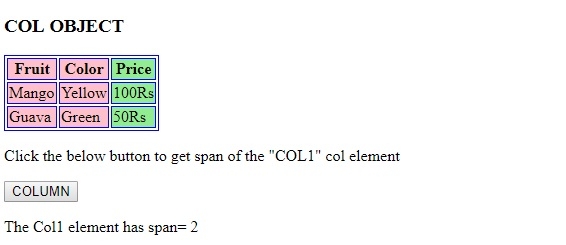
 Data Structure
Data Structure Networking
Networking RDBMS
RDBMS Operating System
Operating System Java
Java MS Excel
MS Excel iOS
iOS HTML
HTML CSS
CSS Android
Android Python
Python C Programming
C Programming C++
C++ C#
C# MongoDB
MongoDB MySQL
MySQL Javascript
Javascript PHP
PHP
- Selected Reading
- UPSC IAS Exams Notes
- Developer's Best Practices
- Questions and Answers
- Effective Resume Writing
- HR Interview Questions
- Computer Glossary
- Who is Who
HTML DOM Column object
The HTML DOM Column object is associated with the HTML <col> element. The Column object is used to get or set the properties of <col> element. The <col> tag is used only inside a <table> element.
Properties
Following is the property for column object −
| Property | Description |
|---|---|
| Span | To set or return the span attribute value of a column. |
Syntax
Following is the syntax for −
Creating a Column object −
var a = document.createElement("COL");
Example
Let us see an example for the column object −
<!DOCTYPE html>
<html>
<head>
<style>
table, th, td {
border: 1px solid blue;
}
#Col1{
background-color:pink;
}
</style>
</head>
<body>
<h3>COL OBJECT</h3>
<table>
<colgroup>
<col id="Col1" span="2">
<col style="background-color:lightgreen">
</colgroup>
<tr>
<th>Fruit</th>
<th>Color</th>
<th>Price</th>
</tr>
<tr>
<td>Mango</td>
<td>Yellow</td>
<td>100Rs</td>
</tr>
<tr>
<td>Guava</td>
<td>Green</td>
<td>50Rs</td>
</tr>
</table>
<p>Click the below button to get span of the "COL1" col element</p>
<button onclick="colObj()">COLUMN</button>
<p id="Sample"></p>
<script>
function colObj() {
var x = document.getElementById("Col1").span;
document.getElementById("Sample").innerHTML = "The Col1 element has span= "+x;
}
</script>
</body>
</html>
Output
This will produce the following output −

On clicking COLUMN button −

In the above example we have created a table with 2 rows and 3 columns. The table overall has a style applied to it. Inside the table, we have two <col> elements with one having span equals 2 and other has an inline style applied to it. Since for the first <col> span equals 2, its style will apply to exactly two columns and the second <col> will apply its style to the remaining columns −
table, th, td {
border: 1px solid blue;
}
#Col1{
background-color:pink;
}
<table>
<colgroup>
<col id="Col1" span="2">
<col style="background-color:lightgreen">
</colgroup>
<tr>
<th>Fruit</th>
<th>Color</th>
<th>Price</th>
</tr>
<tr>
<td>Mango</td>
<td>Yellow</td>
<td>100Rs</td>
</tr>
<tr>
<td>Guava</td>
<td>Green</td>
<td>50Rs</td>
</tr>
</table>
We have then created a button COLUMN that will execute the colObj() method when clicked by the user −
<button onclick="colObj()">COLUMN</button>
The colObj() method gets the first <col> element by using the getElementById() method on document object. It then gets the span attribute value of the <col> element and assigns it to the variable x. The span attribute value that is stored in variable x is then displayed in the paragraph with id “Sample” using the innerHTML property of the paragraph −
function colObj() {
var x = document.getElementById("Col1").span;
document.getElementById("Sample").innerHTML = "The Col1 element has span= "+x;
}
